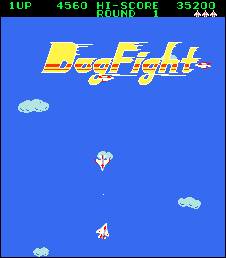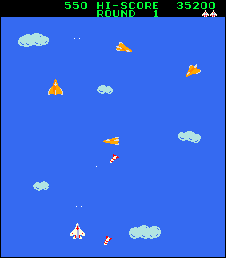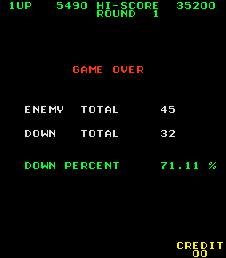 The Game: Enemy fighters arrive, wave after wave, attempting to outflank the player’s fighter jet and trap it in the path of their fire. The player can only move the jet side to side to avoid incoming fire and attempt to line up a shot on the enemy fighters. Each new wave of enemies brings new tactics, new weapons to evade… and a new batch of targets. (Thunderbolt [under license to Orca], 1983)
The Game: Enemy fighters arrive, wave after wave, attempting to outflank the player’s fighter jet and trap it in the path of their fire. The player can only move the jet side to side to avoid incoming fire and attempt to line up a shot on the enemy fighters. Each new wave of enemies brings new tactics, new weapons to evade… and a new batch of targets. (Thunderbolt [under license to Orca], 1983)
Memories: It’s easy to imagine the design and planning meeting for this game. It goes something like this:
“You know what my favorite part of Galaga is? The challenging stage. I hate all those other stages. They’re just there to trip me up on my way to the challenging stage. What if we made a game where the whole thing is like the challenging stage, except they occasionally shoot back at you?”
 That certainly seems to have been the underlying thought process here. At its most basic, Thunderbird’s obscure shoot ’em up Dogfight is challenging stage heaven. Enemies arrive in tight formations, during which players have perhaps a second to get in just the right spot to take out large numbers of the enemy. It’s only if enough of them get through to break formation and begin attacking that the player’s in trouble.
That certainly seems to have been the underlying thought process here. At its most basic, Thunderbird’s obscure shoot ’em up Dogfight is challenging stage heaven. Enemies arrive in tight formations, during which players have perhaps a second to get in just the right spot to take out large numbers of the enemy. It’s only if enough of them get through to break formation and begin attacking that the player’s in trouble.
Audiovisually, Dogfight is neither bad nor spectacular; it’s adequate. It seems to have taken a few visual cues from Time Pilot, but the game could just as easily have been  set in space. The biggest graphics criticism that can be leveled at it is that the enemy’s fire is a single pixel, which is sometimes visually swallowed up in the sky-blue background. (In terms of realism, this is probably entirely accurate, but in terms of gameplay it results in a lot of sudden disintegration of the player’s jet for what at first seems to be no reason at all.)
set in space. The biggest graphics criticism that can be leveled at it is that the enemy’s fire is a single pixel, which is sometimes visually swallowed up in the sky-blue background. (In terms of realism, this is probably entirely accurate, but in terms of gameplay it results in a lot of sudden disintegration of the player’s jet for what at first seems to be no reason at all.)
 Like a lot of arcade fare from this period, especially from smaller manufacturers, Dogfight is neither awful nor amazing. It’s a not-quite-standout game whose inspiration is fairly easy to discern from a few minutes of play.
Like a lot of arcade fare from this period, especially from smaller manufacturers, Dogfight is neither awful nor amazing. It’s a not-quite-standout game whose inspiration is fairly easy to discern from a few minutes of play.